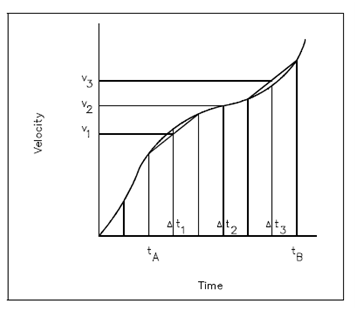Integrals and Summations in Physical Systems:
Differentials and derivatives arose in physical systems while little changes in one quantity were considered. For instance, the relationship among position and time for a moving object led to the definition of the instantaneous velocity, since the derivative of the distance traveled with respect to time, ds/dt. In several physical systems, rates of change are measured straight. Solving problems, while this is the case, includes another aspect of the mathematics of dynamic systems; namely integral & summations.
Figure is a graph of the instantaneous velocity of an object as a function of elapsed time. This is the category of graph that could be generated if the reading of the speedometer of a car were recorded as a function of time.
At any given instant of time, the velocity of the object can be determined through referring to Figure. Therefore, if the distance traveled in a certain interval of time is to be determined, a few new methods must be used. As consider the velocity versus time curve of Figure. Let's consider the velocity changes among times tA and tB .The first approach is to divide the time interval within three short intervals ( Δt1, Δt2, Δt3) , and to suppose that the velocity is constant during each of these intervals. During time interval Δt1, the velocity is supposed constant at an average velocity v1; during the interval Δt2, the velocity is assumed constant at an average velocity v2; during time interval Δt3, the velocity is assumed constant at an average velocity v3. Then

Figure: Graph of Velocity vs. Time
the total distance traveled is approximately the sum of the products of the velocity and the elapsed time over each of the three intervals. Equation 10 approximates the distance traveled during the time interval from ta to tb and represents the approximate area under the velocity curve during this same time interval.
s = v 1 Δt1 + v 2 Δt2 + v 3 Δt3